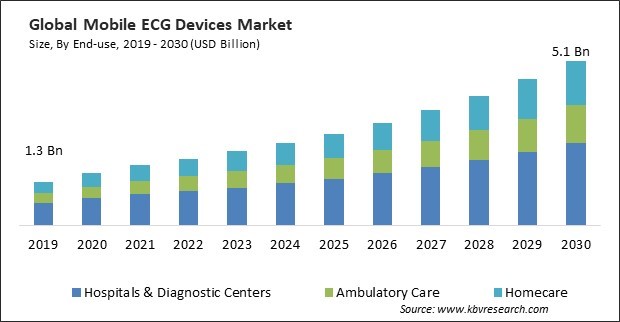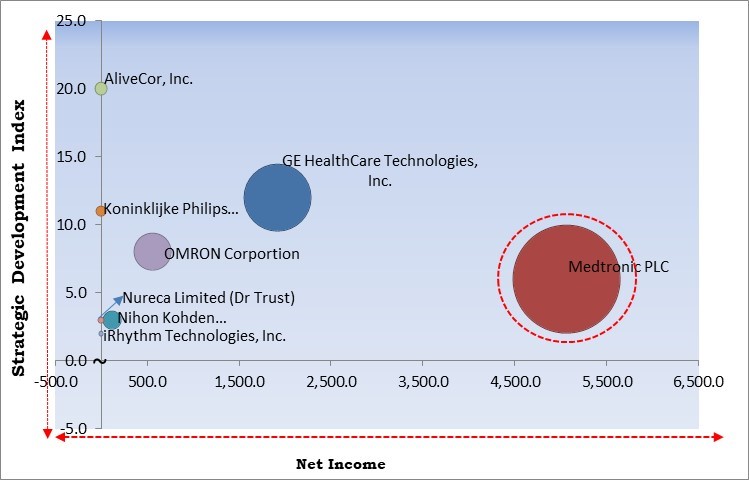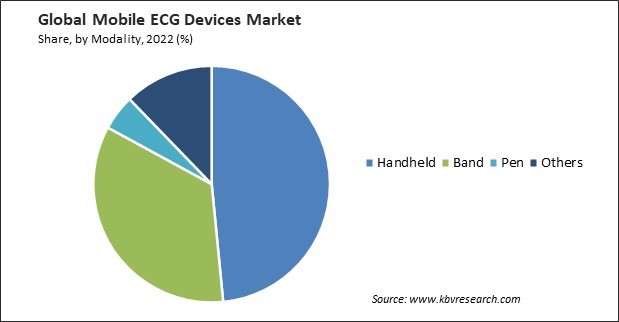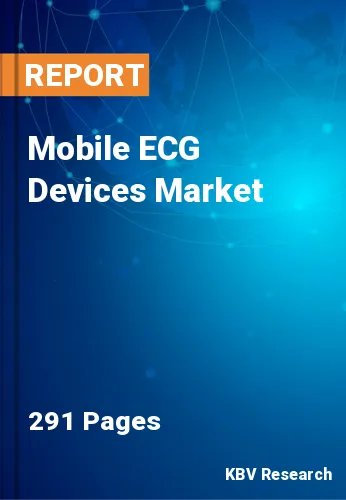The Global Mobile ECG Devices Market size is expected to reach $5.1 billion by 2030, rising at a market growth of 12.2% CAGR during the forecast period. In the year 2022, the market attained a volume of 8,492.6 thousand units, experiencing a growth of 17.5% (2019-2022).
The need for home healthcare products and services is growing in Asia Pacific due to a number of factors, including chronic diseases requiring long-term care, costly in-hospital healthcare facilities, and an underdeveloped healthcare infrastructure. Thus, the Asia Pacific region generated $437.9 million revenue in the market in 2022. Among the developing nations in this region are South Korea, Thailand, Australia, and New Zealand. The aging population, the increasing prevalence of lifestyle diseases, including diabetes and obesity, and technological advancements in patient monitoring devices are all envisioned to drive market growth.

The major strategies followed by the market participants are Partnerships, Collaborations & Agreements as the key developmental strategy to keep pace with the changing demands of end users. For instance, In November, 2022, OMRON Healthcare, Co., Ltd. partnered with CardioSignal to create digital health solutions that would optimize workflow processes for lifestyle chronic diseases, mainly for cardiovascular disease detection at primary care, utilizing the company's motion sensor and ECG technologies. In addition, In August, 2022, Medtronic plc partnered with BioIntelliSense to allow the Medtronic Patient Monitoring business to provide access to a medical-grade device that would offer continuous vital sign measurements of general care patients in-hospital as well as post-discharge.
Based on the Analysis presented in the KBV Cardinal matrix; Medtronic PLC is the major forerunner in the Market. Companies such as GE HealthCare Technologies, Inc., AliveCor, Inc. and Koninklijke Philips N.V. are some of the key innovators in the Market. In March, 2022, GE HealthCare Technologies, Inc. entered into a partnership with AliveCor to provide medical-grade six-lead electrocardiograms (ECGs) taken by patients on an AliveCor KardiaMobile 6L ECG device outside of the hospital setting.

While many patients embraced remote monitoring, some individuals, especially older populations, faced challenges in adopting and using mobile ECG devices. Technological barriers and concerns about device accuracy or security led to hesitancy. This underscored the importance of user-friendly and accessible design in future mobile ECG devices. Moreover, the pandemic accelerated the adoption of telehealth and remote patient monitoring. Patients and healthcare providers increasingly turned to telemedicine solutions to reduce in-person contact, especially in areas with high infection rates. Mobile ECG devices played a pivotal role in this shift, allowing patients to monitor their cardiac health remotely. This surge in telehealth not only increased the demand for mobile ECG devices but also highlighted their importance in providing continuous care to patients, particularly those with heart conditions.
As the global population ages and lifestyle-related risk factors continue to rise, the prevalence of cardiovascular conditions is expected to increase. According to the World Health Organisation (WHO), cardiovascular diseases (CVDs) are the primary cause of death globally, affecting approximately 17.9 million lives annually. Heart attacks and strokes cause more than four out of five CVD-related fatalities, and one-third of these premature deaths occur in individuals under 70. These devices empower users to actively engage in their health management, fostering a proactive approach to their well-being. It has also encouraged a greater emphasis on preventive healthcare, shifting the focus from treatment to early detection and risk reduction. Therefore, the prevalence of cardiovascular diseases exerts a significant and positive impact on the market.
Holistic health monitoring involves the tracking of various aspects of an individual's well-being beyond just heart health. This approach aligns with the broader shift in healthcare toward a more patient-centered and preventive model. The integration of mobile ECG devices with holistic health monitoring features, such as activity tracking, sleep analysis, and stress management, creates a holistic picture of an individual's overall health. Another significant benefit of wearable integration is that it enhances the visibility of ECG data for healthcare providers. Remote patient monitoring is made more effective when ECG data is transmitted directly to a patient's wearable device. As these trends continue to evolve, they are expected to further drive the growth of the market.
One of the primary negative impacts of data privacy and security concerns is a lack of user trust. Patients and individuals who use mobile ECG devices are understandably apprehensive about the safety of their sensitive health data. The fear of unauthorized access, data breaches, or misuse of personal health information can deter individuals from adopting these devices despite their potential benefits. Concerns about data security may lead to healthcare professionals being cautious about using ECG data collected by patients, which can limit the value of remote patient monitoring and telehealth services. This reluctance can impede the seamless adoption of mobile ECG devices into healthcare workflows. Therefore, the significant data privacy and security issues associated with ECG devices may hamper the growth of the market.
Based on modality, the market is divided into pen, band, handheld, and others. The band segment procured a considerable growth rate in the market in 2022. Band-style mobile ECG Devices allow for continuous monitoring of the user's heart rhythm. The device is worn as a band or on the wrist, similar to a watch, and it records ECG data continuously for a long time-usually around the clock. These devices can be programmed to send immediate alerts or notifications if irregular heart rhythms are detected. This can be a lifesaving feature for individuals with conditions like atrial fibrillation or other arrhythmias, as it can prompt timely medical intervention. These benefits make band-style ECG devices a valuable tool for individuals who require continuous cardiac monitoring and proactive heart health management.

On the basis of end-use, the market is divided into hospitals & diagnostic centers, ambulatory care, and homecare. The homecare segment recorded a significant revenue share in the market in 2022. This expansion is ascribed to its affordability and ease of use for at-home medical care. The demand for home healthcare devices is driven by technological advancements as well as the miniaturization of healthcare products, which make them more accessible and user-friendly. Furthermore, the adoption of mobile ECG devices is anticipated to be significantly aided by factors like a growing target population, an increasing need to control healthcare costs, and a significant number of diseases targeted by these devices.
| Report Attribute | Details |
|---|---|
| Market size value in 2022 | USD 2.1 Billion |
| Market size forecast in 2030 | USD 5.1 Billion |
| Base Year | 2022 |
| Historical Period | 2019 to 2021 |
| Forecast Period | 2023 to 2030 |
| Revenue Growth Rate | CAGR of 12.2% from 2023 to 2030 |
| Number of Pages | 291 |
| Number of Table | 534 |
| Quantitative Data | Volume in Units, Revenue in USD Billion, and CAGR from 2019 to 2030 |
| Report coverage | Market Trends, Revenue Estimation and Forecast, Segmentation Analysis, Regional and Country Breakdown, Competitive Landscape, Companies Strategic Developments, Company Profiling |
| Segments covered | Modality, End-use, Region |
| Country scope | US, Canada, Mexico, Germany, UK, France, Russia, Spain, Italy, China, Japan, India, South Korea, Singapore, Malaysia, Brazil, Argentina, UAE, Saudi Arabia, South Africa, Nigeria |
| Growth Drivers |
|
| Restraints |
|
Region-wise, the market is analyzed across North America, Europe, Asia Pacific, and LAMEA. The North America segment witnessed the maximum revenue share in the market in 2022. This region's market is expected to grow significantly due to a number of factors, including a large geriatric population, sophisticated healthcare infrastructure, and comparatively high disposable incomes. Government programs to support home healthcare and lower healthcare costs are anticipated to be major factors in the market's expansion.
Free Valuable Insights: Global Mobile ECG Devices Market size to reach USD 5.1 Billion by 2030
The market research report covers the analysis of key stake holders of the market. Key companies profiled in the report include New York Plastic Surgical Group, PC (Long Island Plastic Surgical Group), Nihon Kohden Corporation, GE HealthCare Technologies, Inc., Medtronic PLC, iRhythm Technologies, Inc., Koninklijke Philips N.V., OMRON Corporation, Nureca Limited (Dr Trust), EMAY, and AliveCor, Inc.
By Modality (Volume, Thousand Units, USD Billion, 2019-2030)
By End-use (Volume, Thousand Units, USD Billion, 2019-2030)
By Geography (Volume, Thousand Units, USD Billion, 2019-2030)
The Market size is projected to reach USD 5.1 billion by 2030.
Increasing prevalence of cardiovascular diseases are driving the Market in coming years, however, Data privacy and security concerns restraints the growth of the Market.
New York Plastic Surgical Group, PC (Long Island Plastic Surgical Group), Nihon Kohden Corporation, GE HealthCare Technologies, Inc., Medtronic PLC, iRhythm Technologies, Inc., Koninklijke Philips N.V., OMRON Corporation, Nureca Limited (Dr Trust), EMAY, and AliveCor, Inc.
In the year 2022, the market attained a volume of 8,492.6 thousand units, experiencing a growth of 17.5% (2019-2022).
The Handheld segment is leading the Market, by Modality in 2022 thereby achieving a market value of $2.3 Billion by 2030.
The North America region dominated the Market, by Region in 2022, and would continue to be a dominant market till 2030; thereby, achieving a market value of $2.2 Billion by 2030.
Our team of dedicated experts can provide you with attractive expansion opportunities for your business.

